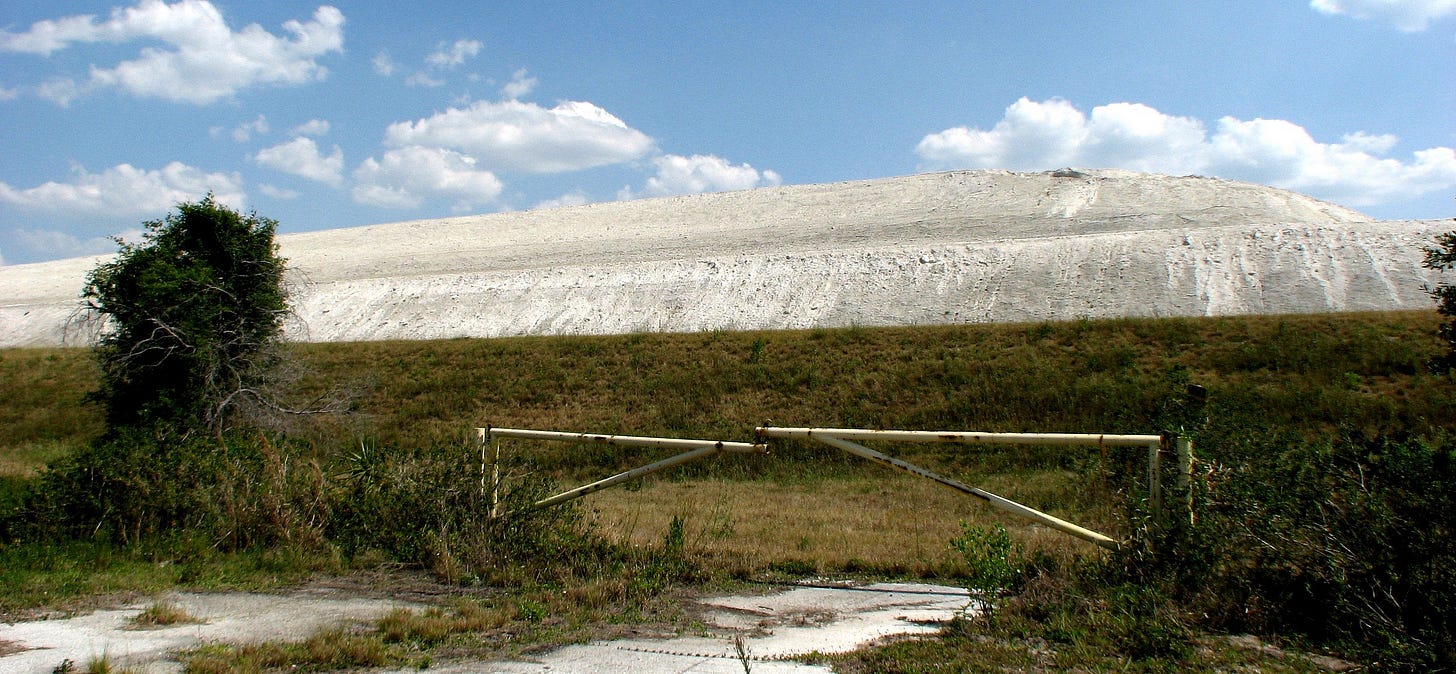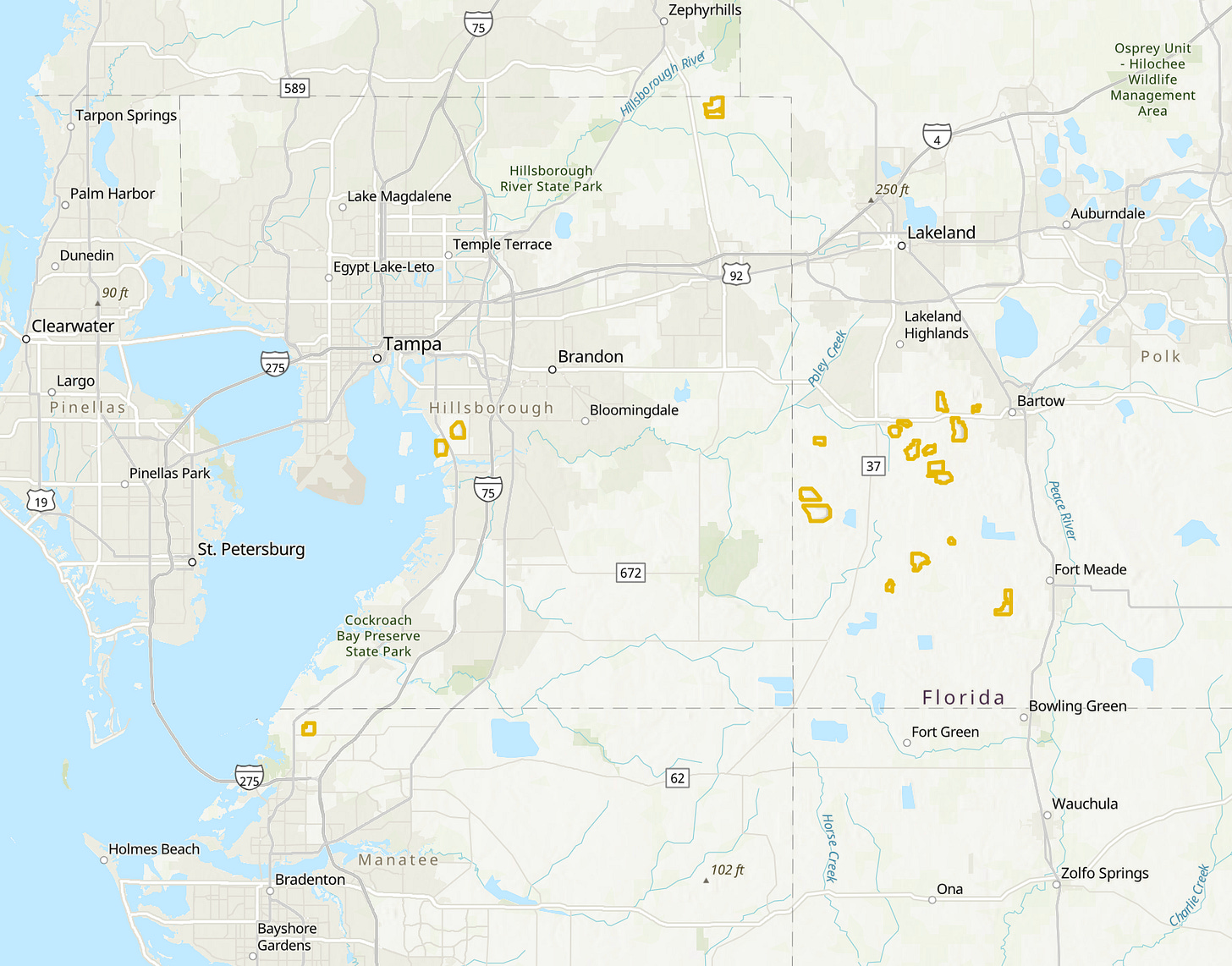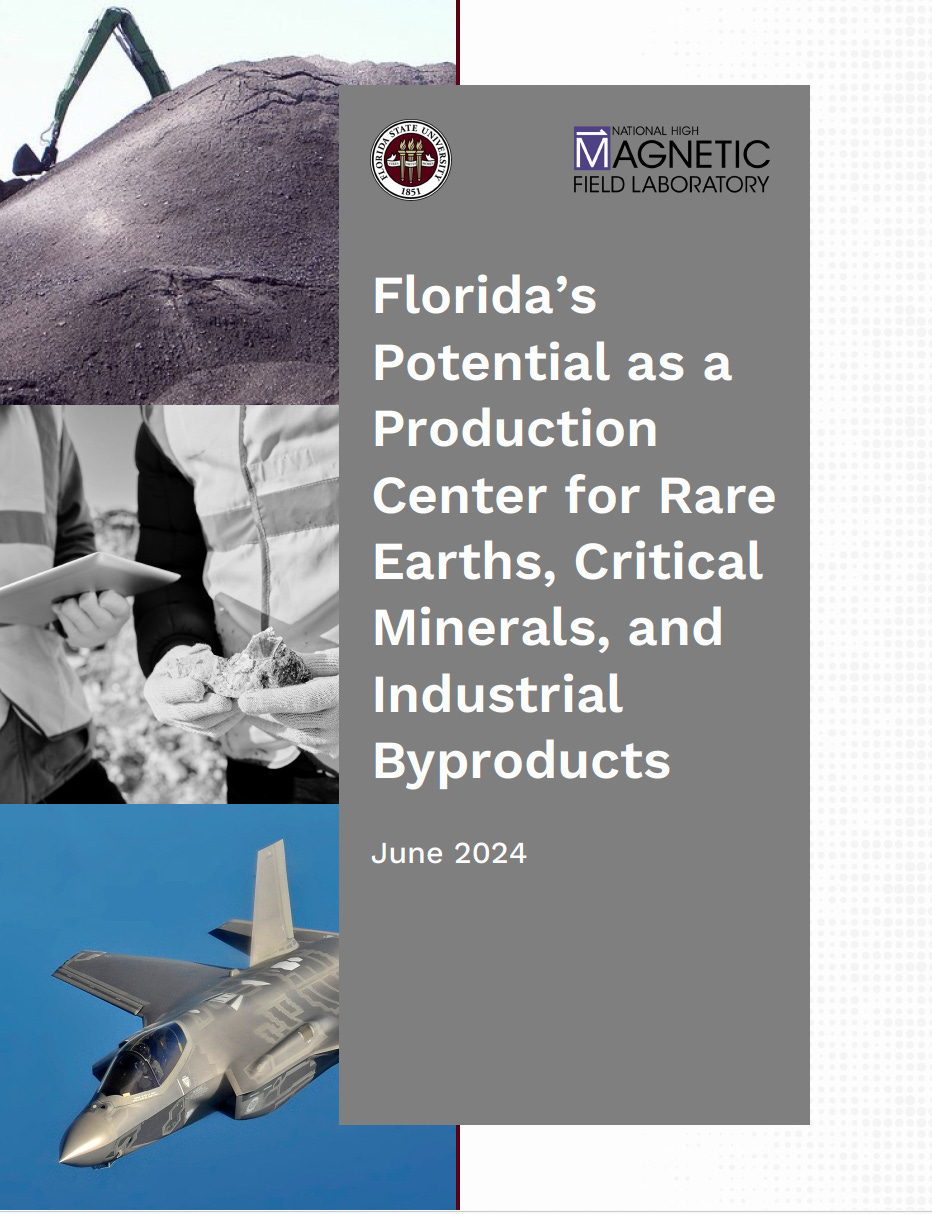Florida has $31 billion trapped in towers of toxic waste
Florida in Five: Five stories to read from the past week in Florida politics.

This is Seeking Rents, a newsletter and podcast devoted to producing original journalism — and lifting up the work of others — about Florida politics, with an emphasis on the ways that big businesses and other special interests influence public policy in the state. Seeking Rents is produced by veteran investigative journalist Jason Garcia, and it is free to all. But please consider a voluntary paid subscription, if you can afford one, to help support our work. And check out our video channel, too.
Welcome to another installment of Florida in Five: Five* stories you need to read from the past week in Florida politics.
One of the largest industrial corporations in the world, the Mosaic Co. rips roughly 10 million metric tons of phosphate rock from the earth every year at open-air mines in central Florida. The company then grinds the rock and reacts it with acid at nearby chemical factories, ultimately turning the material into fertilizer for food crops and animal feed.
One problem, for both Mosaic and the rest of us, is that this process produces a toxic byproduct called phosphogypsum, which is mildly radioactive and must be permanently stored in giant piles that can rise as high as a 50-story building. These are known as “gypstacks,” and there are 25 of them scattered around Florida — all but three of them clustered in west-central Florida between Tampa and Bartow and two-thirds of them owned by Mosaic.
These manmade mountains — which are also topped by ponds of polluted water leftover from the the manufacturing process — are enormous environmental hazards, vulnerable to hurricanes and sink holes and system failures.
They are also, potentially, enormously lucrative. There is an estimated $31 billion worth of raw materials locked inside Florida’s gypstacks right now — including $20 billion worth of rare earth minerals needed for everything from iPhones to electric vehicles; $10 billion worth of gypsum that could be turned into construction aggregates or soil amendments; and $1 billion worth of radium that could be used in cancer radiotherapy drugs.

That’s according to the Center for Rare Earths, Critical Minerals, and Industrial Byproducts, a new research center at the Florida State University launched in 2023 with $20 million from Florida taxpayers.
The challenge lies in figuring out how to economically extract those materials and then safely use them. And that’s the ultimate mission of FSU’s rare earths research center — which Florida lawmakers created during the same session in which they also passed a Mosaic-backed bill ordering the DeSantis administration to evaluate the use of phosphogypsum in road construction.
Researchers at the rare earths center already have some high-level policy recommendations, which could come into play during the Florida Legislature’s annual, 60-day session, which begins next month.
Those recommendations, contained in a report to the governor and top lawmakers, include developing a state-level critical minerals list to match a similar federal program; putting more money into research; and creating a state investment fund that could be used to supplement federal government and corporate spending on critical-mineral extraction.
And while the center stopped short of making more specific proposals, it seems inevitable that this will eventually lead to new industry subsidies.
“Incentives such as tax breaks, grants, and subsidies can stimulate investment in the critical minerals sector,” the center wrote in the June 2024 report. “Developing a robust incentive program will attract companies to invest in extraction and processing technologies, fostering industry growth and innovation.”
Any taxpayer investment in extracting critical minerals from phosphogypsum is obviously going to benefit Mosaic, which would love to transform its toxic mountains from financial, legal and political liabilities into new sources of revenue. In fact, the company has been searching for economically feasible methods to pull rare earth elements from its gypstacks since at least 2021. (Mosaic also just won federal approval to build a test road using phosphogypsum in the road base.)
But at the same time, we all have an interest in finding something to do with this waste rather than leaving it sitting around in piles that amount to ticking time bombs. After all, when disaster strikes at a gypstack, it can contaminate water and kill wildlife. But it can also cost taxpayers: A new state budget that Florida Gov. Ron DeSantis recommended last week includes another $25 million to continue shutting down Piney Point, the site of a 2021 gypstack failure (a non-Mosaic stack) that caused an ecological catastrophe.
So this probably is an important area for Florida leaders to invest in — as long as they make sure taxpayers profit off their investments as much as Mosaic’s shareholders do.
*To paraphrase Barbossa, five is more what you’d call a guideline than an actual rule.
Beta battle
DeSantis goes to battle with Florida Republicans in trying to get closer to Trump (Associated Press)
See also: Casey DeSantis considers running for Florida governor amid push from top donors (NBC News)
It comes from the top
Top DeSantis staff spoke with group pushing state park golf course earlier than known (Tampa Bay Times) ($)
See also: Judge questions DeSantis administration's response time for public records requests (Tallahassee Democrat) ($)
See also: FIU picks Lt. Gov. Jeanette Núñez as acting president after DeSantis request (Tampa Bay Times) ($)
See also: As FAU presidential search nears end, here’s why political clout could figure in (South Florida Sun-Sentinel) ($)
See also: State audit finds overall unnecessary spending under former UF President Ben Sasse (The Independent Florida Alligator)
Session is coming
Political polls would have to disclose sponsors under a GOP senator’s bill (Florida Phoenix)
See also: New bill would crack down on corporations buying Florida homes (Tampa Bay Times) ($)
See also: Florida elections supervisors want to make it easier to vote by mail (Florida Phoenix)
Cost of living crisis
'It's stunning': FIU study paints a grim picture of affordable housing in Palm Beach County (Palm Beach Post) ($)
See also: House prices in Orlando: From $104,000 to $380,000 in 25 years (Orlando Sentinel) ($)
See also: Find out the average price of home insurance in your county, and how much it increased since 2022 (South Florida Sun-Sentinel) ($)
See also: Tampa Electric and Duke are increasing their electric rates starting in March (WUSF)
See also: Live Local Act backlash growing in Fort Lauderdale. But some say give state’s affordable housing law a chance. (South Florida Sun-Sentinel) ($)
Federal election fallout
As big money flows, Boca Raton’s GEO Group readies for migrant evacuation on an industrial scale (Florida Bulldog)
See also: 'Beyond betrayal.' Venezuelans in Florida are angry at Trump immigration policy (NPR)
See also: 'Know your rights': South Florida immigration advocates create rapid response hotline (WLRN)
See also: In bipartisan vote, Miami-Dade County Commission urges Trump to keep TPS for migrants (Miami Herald) ($)
Perspectives
Florida test scores drop again, and all we get are excuses (Orlando Sentinel) ($)
Don't subject USF to New College President Richard Corcoran's poor leadership (Sarasota Herald-Tribune) ($)
DeSantis’ ‘Second Amendment Summer’ is more about his aspirations than Florida’s budget (Miami Herald) ($)







Excellent piece to raise awareness on this. Piney Point was neglected by DeSantis and put the community and DEP employees in harm’s way because he is not an environmentally proactive Governor. It led to having to siphon the phosphogypsum waste into Tampa Bay because as of now “dilution is the solution.” But this is nutrient dense waste, so it causes algal blooms, red tide, fish kills, and health problems in humans and animals.
Bone Valley in Florida is a phosphate goldmine. But the gypsum stacks that house the byproduct can erode and crack and breakdown over time. Seeping into the soil and ground water, and the aquifers that supply drinking water.
There are two major areas where drinking water was contaminated that I’m aware of. One in Lee County and one in Escambia.
In the early 2000’s, the Escambia County news broke about the water utilities company being contaminated (also with PFAS). One can follow an interesting trail of the government attempting to cover this up, propaganda, and a nonprofit environment group exposing the truth, until finally a 2023 $1.1b class action lawsuit settlement. There was an original phosphate mining co there from the late 1800’s that dumped its byproduct into 3 ponds and the Bayou Texar prior to EPA’s existence and environmental regulations. The company was Agrico Chemical Co. The 3 ponds they dumped into sat on top of the aquifer. There are cancer clusters coming out of there, a lot of thyroid disease and cancer, a close loved one being one of them.
In Feb 2024 we saw EPA sued to better handle oversight and management of phosphogypsum.
Here is a 2016 suit against Mosaic for a giant sinkhole that leaked radioactive byproduct and Lee County, where Fort Meyers is, sued. https://www.news-press.com/story/news/2016/09/18/slightly-radioactive-water-seeping-into-aquifer-sinkhole/90617996/#
It’s important to note that Mosaic Peace River Park was once an open pit phosphate mine until the 1980’s, but it wasn’t until the 90’s that a lot of environmental regulations started to take hold. This Mosaic Peace River Park flows to the Peace River, that flows down to Charlotte Harbor, one of two critical habitats for the endangered smalltooth sawfish, which is a spawning habitat. In April 2024, news broke out about the STS behaving erratically, spinning in circles, and dying. https://newrepublic.com/post/180419/florida-smalltooth-sawfish-behaving-erratically-dying
My spouse worked for FDEP for 14 years in their DEAR program, and got his master’s in Water Sustainability from USF. For his thesis, he completed a Peace River study of the Charlotte Harbor and STS critical habitats. This study was requested by NMFS within NOAA, to the EPA, who then requested FDEP perform the study. My spouse worked in the SW ROC, Central ROC, and S ROC of FDEP over the years.
He never got to move forward with officially publishing his study because, well, when the Piney Point critical response happened, he was the Team Lead of the DEAR water quality monitoring, while simultaneously being diagnosed with thyroid cancer within days of this incident. While Piney Point didn’t cause his cancer (it was already wide spread), it did give me a clue when doctors kept asking if he’d been exposed to radioactive substances, and the whole issue around Piney Point phosphogypsum was that it was radioactive. Then I realized a former partner of his also had thyroid cancer, and others he grew up with in Pensacola had thyroid disease. That’s when I learned more about Agrico Chemical Co., Mosaic, Lee County, Bone Valley, etc.
This doesn’t even touch the surface of the PFAS issues in Florida. The EPA has recently reset the regulation from 12 parts per trillion to .004 parts per trillion, but parts of Space Coast are registering at 5,000,000 parts per trillion. I’m not one to cry, but this brought me to tears and made me question if I was hallucinating 0’s. Space X is obviously there, Musk’s company. The flame retardants are high in PFAS, contaminating the area. Stel Bailey founded Fight For Zero, 501c3, and is doing absolutely incredible work around this, and her story is chilling. Exposed to PFAS by the DOD (funds SpaceX) since the 1970’s, her uncle, brother, family dog, and her friend ere all diagnosed with cancer in the same year, 2013. Fight4zero.org
Further, Megan Mullen has created a documentary for her film thesis called Secrets of Satellite Beach to expose the cancer clusters coming out of these areas. Very young people. I’m a therapist and lived in Orlando for 10 years. I contracted with Orlando Health’s employee insurance, and clients worked in the medical care of these very young people all getting the same type of aggressive cancer coming from the East coast and Space Coast area. Their trauma and stress at seeing the systemic connection of government, industrialization, corporate greed, capitalism, environmental contaminant exposure, all taxing Floridian’s health and the Florida hospitals.
https://youtu.be/xj2GnrgSJ_w
This is all in line with Erin Brockovich’s story as well. She is still active, raising awareness about clean water, and has a recently released book called, “Superman’s Not Coming.”
Great reporting, Jason. Thank you.